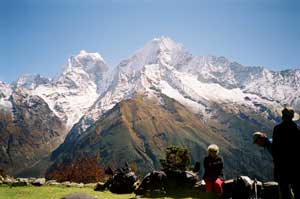 Easy-Moderate: Up to altitudes of around 3,500 m, these usually classic treks are not extremely demanding for anyone with a reasonable/ healthy level of fitness. We've seen all age groups enjoy these treks, from children under ten, to septuagenarians.
Easy-Moderate: Up to altitudes of around 3,500 m, these usually classic treks are not extremely demanding for anyone with a reasonable/ healthy level of fitness. We've seen all age groups enjoy these treks, from children under ten, to septuagenarians.
Moderate-Difficult: Up to 4,500 m. Not all treks in this range are difficult, and there are some that go higher classified as Moderate, such as the classic Annapurna Circuit. This classification is as much to do with the negotiability of terrain by anyone reasonably competent, and the presence of relatively good, well-maintained trails.
Difficult to Strenuous: Up to 5,500 m, these treks are generally non-classic treks that take you into rougher country, terrain, trails and facilities. In addition to being fit, it is recommended that you have solid prior experience in mountain walking.
Strenuous: These are treks that go over 5,500 m and are almost exploratory in terms of the terrain and trails (or lack thereof) you have to navigate. These are only for the hardcore initiated.
Tents or teahouses
The other major decision to make is whether you want to go on a tented trek or a teahouse trek. On a tented trek you do not sleep or eat in the lodges. The staff carry your food and kitchen supplies, as well as the tents you will need. Every evening they will set up camp (for a fee, included in the price quoted to you), often in some of the same villages you would ordinarily stay the night at, or at any other reasonable stop you suggest. Your food is prepared for you by the cook accompanying you, with a mixture of supplies carried in, and local produce to contribute to the economy of the village you are staying at. Your suggestions are always welcome. A toilet tent will also be pitched at every stop.
The advantage of a camping or tented trek is that you really are the master of your time and space here. If you are in a group, in particular, this can be a good way to bond with the people you're walking with. If you're solo or a couple, it is a good way to get some much-needed privacy. You can to a large extent control what you get to eat and when, or even cook, if the fancy strikes you. (This is not irrelevant - for most trekkers, the stomach is the most important organ of the body.) Tented treks epitomise all that walking in the mountains is really about - adventure, roughing it (a little!), truly getting away from it all, and being as close to nature as you can be without sleeping directly under the stars.
A teahouse or lodge trek means that you stay and eat at the lodges along the way. On the classic routes, every planned night stop is well equipped to deal with trekkers - there are numerous lodges that cater to western tourists. There are pros and cons. The beds are usually comfortable, which is a bonus, but the toilets can be far from you at night. The atmosphere can be convivial in teahouses, but in high season this can also mean real overcrowding and delays in the kitchen.
Since not everyone wants the same kind of experience while trekking, based on advice from previous clients we offer a modified and we believe more convenient version of the lodge trek. A teahouse trek organised and supported by Skyline Treks will get you a guide, porters, accommodation in a lodge with breakfast, the conservation area or 'trekking' permit, and land and/ or air transportation to the start and end points of your trek. Skyline Treks costing for teahouse treks includes only breakfast; you are responsible for lunch and dinner, and don't need to eat a pre-ordered meal that your guide orders for you. In virtually all trekking regions with lodges you are expected to eat in the lodge you stay at. The reasoning behind this is that the beds are provided cheap, but to keep a lodge running the owners need to make additional profit. To not eat your meals at your teahouse puts the Skyline Treks guide/ sirdar with you in an awkward and financially disruptive position. Finally, a word on prices: food and drink (especially bottled drinks) cost more the higher you go. It's obvious why - it came up the same trail you did, and someone, a porter, had to carry it up for a fee. So remember that while a lodge trek might seem comparatively cheaper, you're not going to save as much if you drink Coke and beer at high altitude.


